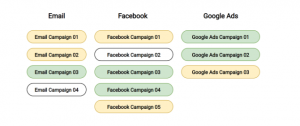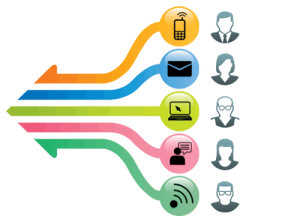
Keeping a healthy Account Based Sales Development operation means providing a steady source of new contacts for each account across all account tiers. We’ve talked at length about selecting and tiering your accounts. Next, you’ll need to fill these accounts and buying centers with specific contacts based on your ideal buyer profiles. This is the fastest way to grow your account-based strategy.
There are many ways to get quality contacts, but in order to sustain a healthy pipeline, you need a predictable and reliable source. Finding a method that balances quantity, quality and price may sound impossible, but in this post we’ll lay out three ways you can strike that balance.
1) Manual Lead Generation – Developing One of the Most Important Sales Development Skill
This skill is one that all SDRs and ADRs (Account Development Reps) should learn to develop. Reps can manually find contacts by looking through social networks (LinkedIn and Twitter at the very least), a company’s website, meetups or conferences, and blogs, forums or discussions boards to name a few.
The key is to get scrappy. Some of the hardest working reps get creative and learn to exploit tools and hacks to begin to automate some of this manual work. Here are some more examples:
- Learn to use Boolean search queries, InMail workarounds, Linkedin groups, and other advanced prospecting tactics on LinkedIn.
- Learn to uncover and verify email conventions. If you know a company uses “first.last@company.com”, then you can figure out email addresses and use a tool like Rapportive to verify.
- Brush up on your technical skills and learn to use Import.io, Kimono, or DataMiner to scrape data.
- Leverage Chrome extensions that will scrape data.
- Don’t forget about your existing data. There are leads currently living in your CRM, Marketing Automation, or ERP systems that can be mined.
If you’re really ambitious and scrappy, get technical. Advancements in technology have enabled sales reps to execute highly technical tasks without requiring highly technical proficiencies. For example, one sales development hack I love to use is APIs and web scrapers to collect the names of everyone who has upvoted a competitive or complementary product on Product Hunt. Another killer example is using BuzzSumo to find popular articles on a given topic or keyword and view all the people who have shared said content on social media. Then use a previously mentioned data scraping tool to collect the data. You can also find top influencers by a given keyword and, again, collect the data. The last “hack” I want to leave you with is leveraging Mention.com (a social monitoring tool) to set up monitoring around your keywords. Then export the list (it only gives you Twitter handles) and use another tool or vendor to enrich the data.
2) Lists Buys and Technology Plays – Leveraging Data Vendors and Intelligence Providers
There are plenty of data firms that have developed their own tools to scrape data (or they may have outsourced the work), who then turn around and sell it. However, this approach comes with a caution: you often get what you pay for. In other words, if a list price is too good to be true, you may be purchasing stale data.
There are other companies that not only scrape data, but also clean and enrich it. These companies build and maintain large databases and supply some of the fastest growing account-based companies with the contacts they need. Some of my favorite companies are Datanyze, LeadGenius, ZoomInfo, InsideView, and DiscoverOrg.
If you take this approach, here are 5 steps to ensure you get data with the most accuracy and integrity.
- Set the baseline data you need – This is the absolute minimum criteria the data provider must supply, such as name, email, company, title, LinkedIn profile, etc.
- Investigate the reputation of the provider – Find out what other people are saying about the quality and integrity of their data by talking with peers and reading reviews on sites like G2 Crowd or TrustRadius.
- Get on the phone with a rep – You must determine the accuracy and integrity of the data first hand. Since data has a limited shelf life and roughly 10 million people change jobs each year, you need to ensure you’re getting your money’s worth. First, ask vendors if they will work with you to match the criteria you need and replace or refund bad leads. Then, ask questions like: “How often do you test and maintain the quality of your database for accurate information?” “Do you filter out spam traps, honeypots, blacklisted domains, and anything else that would hurt my Sender Score?” and “What kind of QA program do you have in place?”
- Get a sample set of data – Ask for a sample data set and use the tools or resources at your disposal to verify the data (one of my favorites is Clearbit). You can also run email addresses through services such as Briteverify or Kickbox.io.
- Diversify your vendors – You want more than one. Never rely on a single source. A mentor of mine used to say, “The most dangerous number in business is one.”
3) Outsourcing – Building Your Own Lead Generation Army
This is a great way to get quality leads at a fraction of the price. It involves working with freelancers (generally overseas) — which can take some resources to build and manage — but the results are worth the cost when you’re up and running.
Here are 5 steps to setting up your outsourcing army.
- Optimize and document your process for manual lead generation – You have to start with your manual process before you can train an outsourced team. Essentially, you’re scaling yourself (or your best SDRs/ADRs). Find the tools and methods for generating leads that work best for your organization, then write it down, step-by-step. You have to systemize before you automize.
- Evaluate and hire freelance workers – After you’ve documented your process down to every last keystroke (yes, you need to get that detailed for freelanced/outsourced workers), post a job listing on sites like Upwork, Mechanical Turk, or Outsourcely. Start off with a 10-hour contract to test the workers for accuracy, volume and ability to follow directions. It’s often useful to provide a template and a sample of the deliverables you’re expecting. If they pass the test, you can then extend the contract. You’ll likely receive a wide range of quotes for your job listing, but stick with people who are in the $ 5-$ 8 per hour range. In my experience, for every five to six people I accept for a test contract, one will really stand out worthy for a longer term contract.
- Clean your data – I hope I’ve stressed enough the importance of clean data. Just because you’ve told your freelancers what you want, doesn’t mean they’ll always follow directions. This is where Clearbit, Kickbox.io, and Briteverify come in handy again.
- Review Worker Performance – If you’re getting 5%-6% bounce rates, it’s time to hire someone else. Make sure to mark your lead source and lead source detail correctly in your CRM, so you can do proper tracking and give more work to your best performers. This also helps with attribution, visibility, and performance management.
- Rinse and Repeat – This isn’t a once and done thing, but rather an ongoing process. By regularly reviewing the work, you’ll ensure quality and know when to let workers go. Also, keep in mind that workers may move on or get busy with other projects. Account for that turnover. Once you nail this down you can predictably and repeatedly get leads for $ 0.37 or less.
Having good pipeline coverage can’t be emphasized enough. It’s one of the most predictive indicators of a sales development organization’s health. And to keep that pipeline full, you must develop a predictable and reliable process for discovering key contacts at your target accounts. In fact, this must remains a priority if you want to be successful with Account Based Sales Development.
Only after you’ve figured this out can you move on to the next step in the Account Based Everything framework: developing account insights.
Business & Finance Articles on Business 2 Community(58)








